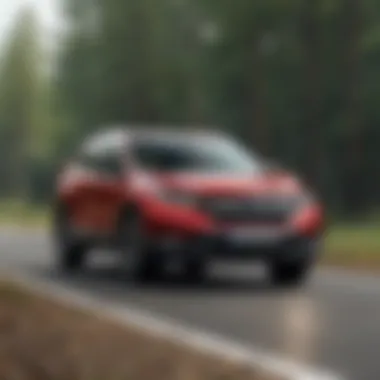Understanding the Honda CRV Sport Mode: Features and Benefits


Intro
The Honda CR-V has been a steady performer in the compact SUV segment. The Sport Mode feature is among the many highlights of this vehicle. Understanding how it functions is crucial for those who seek enhanced driving experience. This feature modifies aspects of the car’s dynamics, including engine responses and transmission behavior. With the right insights, drivers can utilize Sport Mode effectively and enjoy the various advantages it offers.
In this article, we will delve into specific features of Sport Mode, its benefits, and practical use cases.
Market Trends and Insights
Current Industry Trends
The automotive industry has been evolving rapidly. Consumers are increasingly looking for vehicles that offer both performance and efficiency. Sport Mode in SUVs like the Honda CR-V responds to this demand. Many cars now include performance modes. These usually modify throttle response and shift patterns. This customization is significant in attracting driving enthusiasts who prioritize performance alongside everyday usability. Manufacturers are recognizing this trend. As a result, they are engineering sportier dynamics into more models.
Future Projections
As consumers continue to seek a balance between performance and efficiency, we can expect more advancements in features similar to Sport Mode. The push toward electrification will also play a role. Future Honda CR-V models may see hybrid or fully electric variants with advanced performance modes. These modes could include settings specifically targeted for eco-friendly driving while still delivering a driving thrill. The integration of AI in vehicle dynamics is also predicted to enhance the capabilities of driving modes like Sport Mode.
Industry Challenges and Opportunities
Market Barriers
Despite the excitement around enhancing performance, there are also barriers to consider. The demand for fuel efficiency and lower emissions is in tension with performance features like Sport Mode. Manufacturers have to design while balancing both goals. Additionally, the cost of advanced technologies that support these features can be significant. Consumers’ willingness to pay a premium for performance-enhancing features may vary due to economic factors.
Emerging Technologies
Technological advancements present new opportunities for improving Sport Mode. For instance, vehicle dynamics control systems can fine-tune performance metrics in real-time. Innovations in transmission design can further enhance responsiveness. These emerging technologies promise to bring about more refined driving experiences. Moreover, advancements in software can provide drivers with more data on their driving patterns, promoting better use of Sport Mode.
Understanding the implications of these trends and challenges is essential. It allows consumers to make informed decisions. The benefits of engaging Sport Mode in the Honda CR-V can certainly enrich the driving experience, but understanding the landscape is equally important.
Prelude to Honda CRV Sport Mode
The Honda CRV Sport Mode represents a significant enhancement in driving dynamics. It serves as a gateway for drivers seeking an experience beyond just transportation. Understanding this feature provides insights not only into the vehicle's capabilities but also how it aligns with modern driving expectations.
Definition of Sport Mode
Sport Mode in vehicles like the Honda CRV is a driving setting that modifies the car's performance parameters. This can include adjustments to the engine response, transmission settings, and steering characteristics. When activated, Sport Mode typically results in a more engaging driving experience, offering quicker throttle response and more aggressive power delivery. It is primarily designed to increase driving enjoyment, especially in spirited driving scenarios.
Overview of Honda CRV
The Honda CRV is one of the most popular compact SUVs on the market. It blends practicality with comfort and efficiency. Honda has invested in technology that caters to driving preferences, including Sport Mode. The CRV's design emphasizes versatility, with ample space and advanced features. The inclusion of Sport Mode is a testament to Honda's commitment to enhancing the driver experience. As the automotive landscape evolves, the CRV continues to adapt, balancing performance with its reputation for reliability and comfort. Understanding how Sport Mode integrates into the overall Honda CRV experience is essential for prospective buyers and enthusiasts alike.
Mechanics Behind Sport Mode
Understanding the mechanics of Sport Mode is vital for those who wish to optimize their driving experience in the Honda CRV. This mode not only refines the vehicle's performance but also alters the way it responds to varied driving conditions. By focusing on specific elements such as engine adjustments, transmission modifications, and steering dynamics, one can appreciate how Sport Mode operates and its benefits.
Engine Adjustments
In Sport Mode, the Honda CRV makes significant adjustments to its engine parameters. This involves altering the throttle response to provide faster acceleration. In essence, the engine operates on a more aggressive calibration, which enhances the vehicle’s overall response to the driver's input. This means that the SUV accelerates more readily, allowing for a more dynamic driving experience.
Such adjustments lead to a heightened sense of power, especially during overtaking maneuvers or when merging onto highways. The engine can sustain higher RPMs, ensuring that the driver has access to required power without delay. This immediacy is particularly beneficial in scenarios where quick responses are crucial.
Transmission Modifications
Transmission plays a crucial role in how power is delivered from the engine to the wheels. When engaging Sport Mode, the Honda CRV changes the shift points of its automatic transmission. The gears are held longer in each range, which provides a more seamless transition and also maximizes engine output.


This modification prevents the vehicle from prematurely shifting to higher gears, allowing the engine to perform closer to its peak performance band. Consequently, drivers may experience reduced lag and improved acceleration, particularly during spirited driving. While this enhances the driving experience, it’s important to recognize that it may result in a slightly different feel compared to the smoothness of normal driving modes.
Steering Dynamics
The steering in Sport Mode is also refined to augment driver feedback, which allows for greater engagement and control. The steering system tightens, providing a more connected feel between the driver and the road. This kind of adjustment offers a more immediate response to steering input.
Through these changes, drivers may find that navigating turns becomes not only more responsive but also more enjoyable. This added feedback can instill a greater sense of confidence, especially in challenging driving conditions or when navigating winding roads.
Engaging Sport Mode can transform the driving experience, shifting it from merely getting from point A to point B to an engaging and responsive journey.
Overall, each of these mechanical adjustments contributes to creating a driving experience that is distinctly sportier. Drivers will find that the Honda CRV in Sport Mode offers enhanced engagement and performance compared to standard driving settings.
Advantages of Using Sport Mode
Engaging Sport Mode in the Honda CRV provides distinct advantages for drivers seeking a more dynamic and responsive driving experience. This mode transforms the vehicle's performance capabilities and overall driving feedback, catering specifically to those who value agility and immediacy in their automotive interactions. In this section, we will explore the critical elements of Sport Mode, including enhanced performance, improved responsiveness, and the increased driver engagement it offers.
Enhanced Performance
One of the primary benefits of using Sport Mode is the marked enhancement in vehicle performance. When activated, Sport Mode adjusts various engine parameters, including throttle response. This modification results in quicker acceleration and a more robust power delivery. The Honda CRV responds more assertively, making it suitable for scenarios requiring swift maneuvers, such as merging onto highways or navigating through city traffic.
Moreover, the modifications to the transmission system create a more engaging driving experience. In Sport Mode, shift points are optimized for higher RPM, allowing for more aggressive driving and increased efficiency in power usage. This adjustment enables drivers to feel a stronger, more immediate connection with the vehicle's capabilities, providing both confidence and excitement during the drive.
Improved Responsiveness
Responsiveness is critical for any driver, particularly those who appreciate a more connected drive. Sport Mode elevates the CRV's responsiveness by recalibrating the electronic systems controlling the accelerator and steering. This calibration leads to a more immediate reaction to driver input, fostering a sense of control that enhances the overall driving experience.
When accelerating or cornering, drivers notice a tangible difference in how the vehicle responds. The precise adjustments create a synergy between the driver and the machine, allowing for seamless transitions through various driving conditions. Whether navigating tight corners or executing swift lane changes, the improved responsiveness offers reassurance and satisfaction to those behind the wheel.
Driver Engagement
Another crucial advantage of Sport Mode lies in the increased driver engagement it fosters. Unlike standard driving modes that prioritize fuel efficiency, Sport Mode invites drivers to partake in a more exhilarating driving experience. The enhanced feedback from the steering and the engaging sound of the engine contributes to a more immersive driving environment.
By activating this mode, drivers are more likely to feel involved in the driving process. It encourages cautious decisions and boosts confidence in handling the vehicle. Whether on a winding road or in urban settings, the proactive engagement with Sport Mode makes driving an enjoyable endeavor.
Activating Sport Mode not only enhances performance but also transforms how a driver interacts with their Honda CRV.
Practical Applications of Sport Mode
Understanding the practical applications of Sport Mode in the Honda CRV reveals its importance in enhancing driving experiences under various conditions. Sport Mode is not just a feature for performance enthusiasts; it serves distinct purposes across different driving environments. By activating this mode, drivers can achieve better control, responsiveness, and overall enjoyment, leading to a more engaging journey.
City Driving
In urban settings, where traffic situations can shift unexpectedly, Sport Mode can significantly improve driver reaction times. With enhanced throttle response, the Honda CRV provides immediate power when merging, accelerating, or navigating through congested zones. This level of responsiveness assists in maneuverability, making it easier to handle quick stops and starts.
Moreover, the increased steering feedback allows the driver to feel more connected to the vehicle. Such control can be particularly beneficial in crowded areas, helping to mitigate stress during everyday commutes. The improved acceleration also helps in seamlessly merging into traffic, which can be crucial in busy city environments.
Highway Driving
On highways, the advantages of Sport Mode become even more apparent. Here, the Honda CRV's ability to deliver quick bursts of power helps when overtaking slower vehicles. This advantage not only improves travel speed but also enhances safety, as it reduces the time spent in potential blind spots.
Additionally, the refined steering dynamics allow for better cornering at higher speeds. The increased stability and control contribute to an overall more defined driving experience. When engaging in long-distance travel, Sport Mode also helps manage the driver’s comfort by providing an engaging experience without sacrificing vehicle responsiveness.
Off-Road Scenarios
For those adventurous enough to take the CRV off the beaten path, Sport Mode proves beneficial as well. Although the CRV is not primarily designed for extreme off-roading, activating Sport Mode allows the vehicle to handle rough terrains more effectively. The heightened engine response can provide the necessary power to navigate steep inclines or rocky surfaces.


Moreover, in off-road situations, the suspension may react more dynamically, allowing for better ground contact and control. This added responsiveness can prevent wheel slip and enhance traction, making it easier to tackle obstacles and uneven surfaces. Understanding these capabilities broadens the utility of the Honda CRV, affirming its versatility.
"Sport Mode not only enhances the driving experience but also adds a practical layer of functionality across various environments."
Comparative Analysis: Sport Mode vs Other Driving Modes
Understanding the distinctions between Sport Mode and other driving modes in the Honda CRV unveils the versatility embedded within this vehicle. Each mode is designed with unique characteristics that cater to different driving scenarios and preferences. The comparative analysis highlights the specific elements, benefits, and considerations concerning Sport Mode versus other configurations such as Eco, Normal, and specialized modes for adverse weather conditions. This understanding allows drivers to optimize their CRV's performance based on driving conditions and personal preferences.
Eco Mode Capabilities
Eco Mode is tailored for fuel efficiency. When activated, this mode adjusts the engine's response to deliver power more gradually. This results in reduced fuel consumption, ideally suited for city driving or scenarios where long distances are covered without high speed. In Eco Mode, the vehicle shifts earlier and maintains lower engine revs, effectively promoting efficient driving habits.
- Fuel Economy: The main advantage of Eco Mode is its potential for substantial fuel savings, which appeal to environmentally conscious drivers.
- Driving Experience: While fuel-saving is a priority, the trade-off involves a slight reduction in acceleration responsiveness, which may not appeal to all drivers.
- Engine Management: Under this mode, the engine management system optimizes various parameters to foster balanced driving efficiency.
Normal Driving Mode
Normal Driving Mode presents a balanced approach between performance and comfort. It is designed for everyday driving scenarios, providing a harmonious mix of responsiveness and fuel efficiency. This mode adjusts the throttle inputs to offer a comfortable driving experience without compromising safety.
- Driving Comfort: The Normal Mode provides a pleasant driving experience, allowing for smooth acceleration.
- Versatility: Ideal for various driving conditions, whether city commuting or short highway trips, making it an all-around practical choice.
- Safety Features: Stability controls and many safety features are operational, making it a reliable choice for everyday drivers.
Snow and Mud Modes
The Snow and Mud Modes specialize in handling adverse weather conditions. These modes modify how the vehicle interacts with the road, enhancing safety and control during challenging situations.
- Traction Control: Each mode engages specific features to prevent wheel slip and maintain traction on slippery surfaces.
- Throttle Response: In Snow Mode, throttle response is softened, allowing for smoother power delivery. Mud Mode adjusts for maximum traction with a more aggressive approach.
- Driver Confidence: These modes instill a greater sense of security in drivers navigating through challenging conditions, by adjusting the vehicle's capabilities effectively.
Optimal driving experience relies heavily on understanding these distinct modes. Choosing the right one at the right time can enhance both safety and enjoyment during your drive.
In summary, comparing Sport Mode with other driving modes illuminates the importance of adaptability in the Honda CRV. Each mode has its unique purpose, allowing drivers to select the appropriate setting according to specific requirements and driving conditions.
Impact of Sport Mode on Fuel Efficiency
Understanding the impact of Sport Mode on fuel efficiency is crucial for potential Honda CRV owners and existing drivers interested in optimizing their driving habits. This section provides insight into how engaging Sport Mode can alter fuel consumption and what this means in practical terms. While the primary purpose of Sport Mode is to enhance performance, it is also important to consider the trade-offs regarding fuel efficiency.
Fuel Consumption Dynamics
When Sport Mode is activated, the vehicle's engine and transmission are tuned for a more responsive and dynamic driving experience. This typically results in increased fuel consumption. The Honda CRV's engine revs higher and accelerates faster, which often requires more fuel. The adjustments made in Sport Mode can lead to:
- Higher RPMs: The engine operates at higher revolutions per minute, consuming more fuel in the process.
- Quicker Acceleration: This demands more power from the engine, further increasing fuel use.
- Less Efficient Shifting: The transmission shifts differently to enhance performance, which may not align with optimal fuel efficiency.
Consequently, while driving in Sport Mode can be thrilling, it is typically at the expense of additional fuel consumption.
Balancing Performance and Efficiency
Finding the right balance between performance and fuel efficiency in the Honda CRV when using Sport Mode is key. Drivers should be aware of their driving environment and personal needs. Here are some considerations:
- Purpose of Driving: If a driver is navigating through city traffic, Sport Mode might provide limited benefits compared to the increased fuel cost. Alternatively, during highway driving, the responsive nature of Sport Mode can improve the driving experience, albeit with a sacrifice in fuel economy.
- Short Bursts: Utilizing Sport Mode for short periods or during specific scenarios can help manage fuel consumption while still taking advantage of enhanced driving dynamics.
- Performance Needs: For drivers prioritizing an engaging driving experience, the trade-off of fuel efficiency may be a worthwhile investment. However, those who focus on savings and environmental impact may want to use Sport Mode selectively.
As you engage Sport Mode, consider both your performance desires and fuel expectations. Optimal driving often means recognizing when to push for performance and when to conserve fuel.
In summary, while Sport Mode in the Honda CRV can enhance performance and provide a more engaging driving experience, it generally leads to increased fuel consumption. Savvy drivers can find ways to balance performance and fuel efficiency by understanding when to deploy this feature.
User Experience and Feedback


In the context of the Honda CRV Sport Mode, user experience is essential for understanding how effectively the feature meets the needs of its drivers. Feedback from owners and professionals helps in recognizing the practical uses and limitations of Sport Mode. Insights from real-world experiences provide clarity on how Sport Mode transforms driving dynamics and daily usability.
Owner Testimonials
Owner testimonials offer valuable perspectives on the efficacy and appeal of Sport Mode. Many Honda CRV owners have reported a more engaging driving experience when using this feature. Users frequently mention a noticeable enhancement in acceleration and overall responsiveness. For instance, one owner highlighted, "Switching to Sport Mode significantly changes the feel of the vehicle; it becomes much more eager and alive on the road."
Feedback from other users aligns with this sentiment. Many owners appreciate how Sport Mode allows for greater control in varying driving conditions. Although some drivers admit they do not use it daily, they still find it enjoyable when the situation calls for spirited driving.
However, it is important to note some owners have pointed out the fuel economy trade-off. When engaged, the vehicle tends to consume more fuel, as it prioritizes performance over efficiency. A noted comment stated, "I love using Sport Mode, but I have to be cautious about fuel consumption during my city commutes."
Professional Reviews
Professional reviews add another layer of comprehension regarding Sport Mode in the Honda CRV. Automotive experts often scrutinize the feature through rigorous testing and evaluations. Many reviews commend the implementation of Sport Mode, describing it as a significant advantage for the CRV compared to competitors.
Reviewers have remarked on the swift throttle response and re-tuning of the transmission as particularly effective. A typical review might indicate, "Honda’s Sport Mode equips the CRV with impressive agility, allowing it to respond promptly to driver inputs, which enhances the overall driving experience."
Additionally, professionals often address performance limitations. Some reviews mention that while Sport Mode enhances speed and acceleration, it can slightly compromise ride comfort due to stiffer steering feel. This aspect is crucial for potential buyers to consider, as the driving experience might differ depending on individual preferences.
Potential Drawbacks of Sport Mode
When considering the Honda CRV's Sport Mode, it is crucial to examine the potential drawbacks alongside its advantages. Sport Mode emphasizes enhanced performance, but it may also bring some challenges. Understanding these limitations will help users make informed decisions on when and how to utilize the feature.
Performance Limitations
While Sport Mode significantly improves the vehicle's responsiveness and acceleration, it does come with performance limitations. One primary concern is that while its functionality is optimized for dynamic driving, it may not be suitable for all conditions. For instance, in heavy traffic or adverse weather conditions, engaging Sport Mode might lead to increased revs without translating to actual speed. This can create an unnecessary strain on both the vehicle and the driver, as they may find themselves battling with a heightened sense of urgency that is not warranted by their environment.
Additionally, Sport Mode recalibrates engine power to provide more torque, but this does not equate to improved handling or braking capabilities. Drivers should note that while they're benefitting from turbocharged acceleration, their stopping distance might not decrease accordingly, posing a risk in emergency situations.
Increased Wear on Components
Another notable drawback to consider is the potential for increased wear on vehicle components. Using Sport Mode regularly can place more stress on the engine, transmission, and brakes. The constant high-rev operation can lead to quicker deterioration of vital parts, such as the clutch and brake pads.
Furthermore, frequent engagement of Sport Mode can contribute to the overall wear and tear of the drivetrain. With modifications to the car's mechanics to optimize performance, the risk of mechanical issues such as overheating or reduced longevity of components increases.
To maximize longevity, it could be beneficial for drivers to alternate their driving modes based on conditions and driving style. This balanced approach maintains the thrill that Sport Mode provides while protecting the vehicle's essential components from early failure.
"Understanding both the advantages and drawbacks of Sport Mode gives drivers a more comprehensive perspective on its use."
In summary, while the Honda CRV's Sport Mode is designed for an exhilarating driving experience, it is important to remain aware of its limitations. Careful consideration and responsible driving can help mitigate potential risks and ensure the vehicle remains in optimal condition for years to come.
Finale
The conclusion of this article highlights the significance of Sport Mode within the Honda CRV. This feature offers drivers a more dynamic and engaging experience, aligning with the desires of those who seek performance without sacrificing practicality. By summarizing the capabilities and functionalities of Sport Mode, readers can appreciate how this mode not only enhances driving experiences but also caters to specific driving needs.
Summary of Insights
In summary, the Honda CRV's Sport Mode goes beyond mere engine modifications. It intelligently adjusts the transmission and steering dynamics for a more responsive driving feel. Owners of the Honda CRV can utilize this feature during various driving conditions, enabling a tailored experience that enhances performance. Feedback from owners and professionals underscores these benefits, marking Sport Mode as a critical aspect of the vehicle's design.
Key insights include:
- Enhanced acceleration and responsiveness.
- A balance between performance and comfort.
- Practical applications across various driving scenarios.
These insights affirm that Sport Mode is not just a luxury, but a functional enhancement that carries real-world benefits.
Final Thoughts on Sport Mode
Considering all factors, the Honda CRV’s Sport Mode is an indispensable tool for enthusiasts who appreciate agility and performance. However, potential drawbacks such as increased fuel consumption and wear on components should also be taken into account. By understanding how Sport Mode interacts with the vehicle’s systems, drivers can make informed choices about when to engage this feature.
This comprehensive guide underscores Sport Mode's importance, not just as a feature, but as a contributor to the overall driving enjoyment. Vehicle owners are encouraged to explore this mode while being mindful of its impacts on fuel efficiency and component longevity.
Ultimately, the choice to use Sport Mode is about balancing thrill and practicality, making it a valuable addition to the driving toolkit of the Honda CRV owner.







